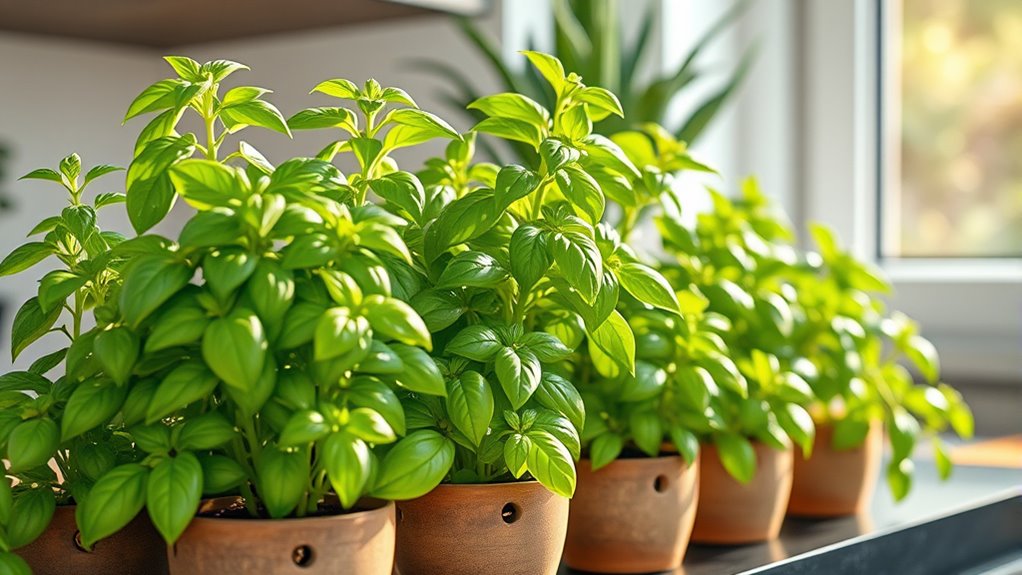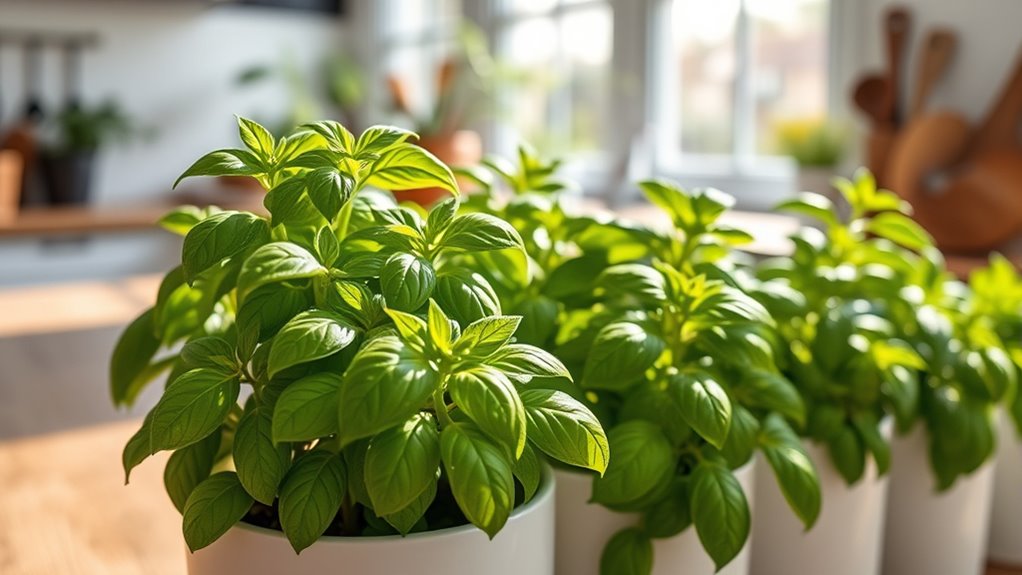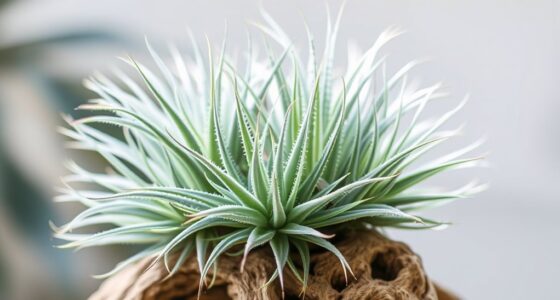To grow fresh basil indoors year-round, place it in a sunny spot or use grow lights for at least six hours daily. Water consistently, checking soil moisture to prevent over or underwatering. Keep temperatures between 70-80°F and watch for pests like aphids or spider mites. Using well-drained soil and proper care guarantees lush, flavorful leaves all year. If you want to uncover more tips, you’ll find helpful guidance below.
Key Takeaways
- Provide at least six hours of direct sunlight or use grow lights to ensure healthy basil growth indoors year-round.
- Maintain indoor temperatures between 70-80°F and avoid drafts for optimal basil development.
- Water consistently, checking soil moisture regularly, and adjust watering based on seasonal humidity and heating.
- Use well-drained soil and proper containers to prevent root rot and promote healthy root systems.
- Regularly inspect leaves for pests like aphids and treat early with natural insecticides to keep basil pest-free year-round.

If you love fresh basil year-round, cultivating all-year basil is a game-changer. Growing basil indoors means you can enjoy fragrant, vibrant leaves no matter the season. But to keep your plants thriving, you need to pay attention to common challenges like seasonal pests and watering schedules. When growing basil indoors, pests such as aphids, spider mites, and whiteflies can still find their way onto your plants, especially during certain times of the year. Keeping an eye out for these pests is essential because they can quickly damage your basil or spread to other houseplants. Regularly inspect your basil’s leaves, especially the undersides, and if you notice tiny bugs or sticky residue, treat the problem early with natural insecticidal soap or neem oil. This proactive approach prevents infestations from becoming overwhelming, ensuring your basil stays healthy and productive year-round.
Watering schedules are equally vital for indoor basil. Unlike outdoor plants that rely on natural rainfall, indoor basil depends entirely on you for consistent watering. Overwatering can lead to root rot, while underwatering causes the leaves to wilt and lose flavor. Establish a routine where you check the soil moisture regularly—stick your finger about an inch into the soil; if it feels dry, it’s time to water. Basil prefers moist but well-drained soil, so watering thoroughly until excess drains out the bottom of the pot is ideal. During winter months, when indoor heating tends to dry out the air, you might need to water more frequently. Conversely, in more humid seasons or cooler months, reduce watering to prevent soggy soil. Maintaining a steady watering schedule helps your basil grow lush and flavorful, and it minimizes stress on the plant, making it more resilient against pests and diseases. Additionally, ensuring proper soil quality can significantly affect your basil’s health and growth potential.
Growing basil indoors also means managing environmental factors such as light and temperature, but consistent watering and vigilance against pests are your primary tools for success. Keep your basil in a bright spot with at least six hours of direct sunlight daily, or supplement with grow lights if natural light is limited. Maintain a warm environment around 70-80°F, and avoid sudden drafts or temperature drops. By combining proper watering habits with proactive pest control, you set the stage for thriving basil plants that can produce fresh leaves all year long. Whether you’re using a small pot on your kitchen windowsill or a more elaborate indoor garden setup, these practices keep your basil healthy, flavorful, and ready to enhance your meals anytime you need.
Frequently Asked Questions
Can Basil Be Grown Successfully Without Direct Sunlight?
You can grow basil without direct sunlight by choosing varieties with higher shade tolerance. While basil prefers plenty of light, it can thrive indoors with artificial lighting like LED grow lights, which provide the necessary spectrum. Make sure to place the lights close enough and keep them on for about 12-16 hours daily. This way, you’ll successfully grow fresh basil even in low-light conditions.
What Are the Best Indoor Containers for Basil Growth?
Imagine your basil thriving like a sun-kissed garden—your choice of container makes all the difference. Opt for containers with good air circulation, like clay or breathable ceramic pots, to prevent mold and promote healthy roots. Avoid plastic, which traps moisture. Choose sizes that give basil room to grow, with drainage holes to keep roots happy. Your herbs will flourish in containers designed to mimic their outdoor environment indoors.
How Often Should I Water Indoor Basil Plants?
You should water your indoor basil plants based on their soil moisture. Typically, watering frequency depends on factors like temperature and humidity, but aim to keep the soil consistently moist without overwatering. Check the top inch of soil; if it feels dry, it’s time to water. Avoid letting the soil dry out completely or stay soggy, as both can harm your basil’s health.
Does Indoor Basil Need Fertilizing, and How Often?
Did you know basil plants grow best with extra nutrients? Indoor basil needs fertilizing about once every 4 to 6 weeks, especially during active growth. You should use a balanced, water-soluble fertilizer to replenish soil nutrients. Stick to a consistent fertilizing schedule, and avoid overfeeding, which can harm your plant. Regular feeding helps make certain your basil stays healthy and flavorful all year long.
How Can I Prevent Pests on Indoor Basil Plants?
To prevent pests on your indoor basil, start with good pest prevention practices like keeping your plant healthy and clean. Regularly inspect your basil for signs of pests and remove any affected leaves. Use organic pest control methods such as neem oil or insecticidal soap to manage issues early. Consistent monitoring and maintaining a clean environment help keep pests at bay, ensuring your basil stays fresh and pest-free year-round.
Conclusion
With a little care, your basil can flourish year-round, turning your home into a green oasis. Think of it as nurturing a tiny garden that breathes life into every corner, no matter the season. Just water, light, and patience are all you need to keep your herbs thriving indoors. Soon, you’ll enjoy fresh, fragrant basil whenever you want—proof that with a bit of effort, your culinary dreams can bloom endlessly.









